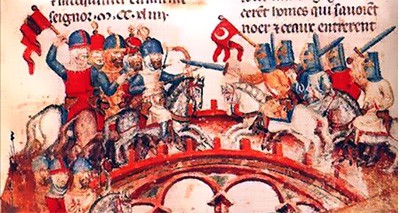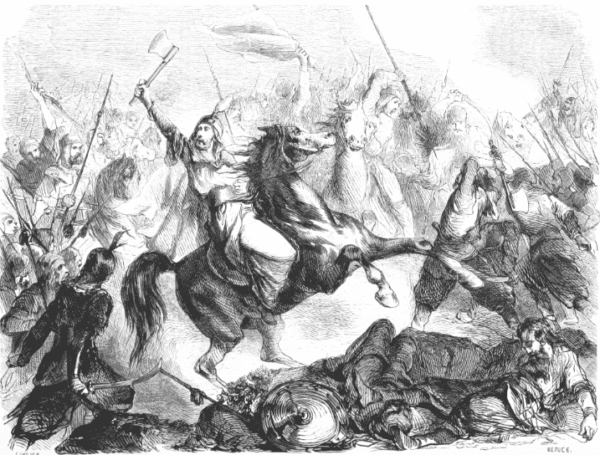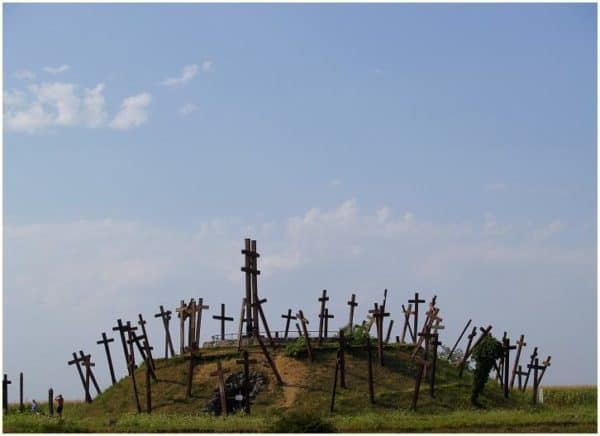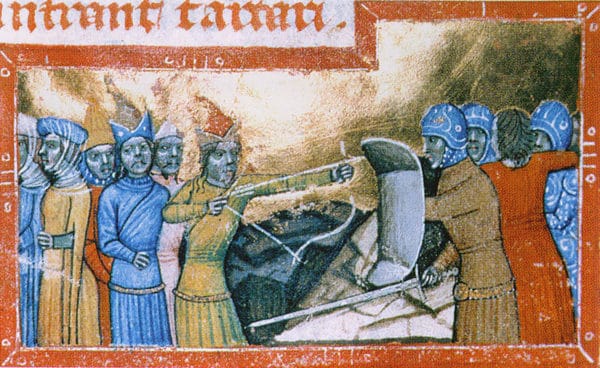How Poles and Hungarians Turned Back the Mongol Horde and Saved Europe
Sinclair Jenkins, American Renaissance, March 27, 2020

In the midst of worries about the Wuhan coronavirus, it is worth remembering that the scholarly consensus has long been that the Black Plague reached the Mediterranean in 1347 because of the Mongol invasion of Crimea. The Mongol Empire and its derivative kingdoms were, themselves, considered plagues at the time. Some modern historians celebrate Mongol religious tolerance — historian Jack Weatherford has called its capital city Karakorum “the most religiously open and tolerant city in the world at that time” [1] — but the rest of the world, whether Muslim, Christian, or Hindu, viewed the Mongols as devils.
Arguably the worst Mongol savagery was in 1258, when Hulagu Khan and his Ilkhanate Empire (along with allies from the Christian states of the Armenian Kingdom of Cilicia, the Kingdom of Georgia, and the Principality of Antioch) destroyed Baghdad, thus ending the so-called “Islamic Golden Age.” The Mongols raped and pillaged for days, destroyed the city’s libraries and universities, and murdered at least 3,000 of the city’s notables. The Mongol destruction of Baghdad was far worse for the Muslim world than the Crusades; Muslims flourished in the Crusader states after the fall of Jerusalem in 1099.
The Mongols did not spare Europe. The horsemen from Central Asia invaded at a time when the formerly great state of Kievan Rus’ was fractured. On May 31, 1223, a Mongol army of approximately 20,000 defeated an alliance of Russian princes at the Battle of Kalka River, when the principalities and duchies were already exhausted after years of civil war.

Battle of the Kalka River
Mongols then raided and laid siege to all the major settlements in Russia and Ukraine. In 1237, a Mongol army burned Moscow to the ground. Three years later, Mongols took Kiev, thus conquering all Kievan Rus’ territory [2]. The “Tatar yoke” of Russia lasted until 1480, and is often invoked to explain why Russia is so culturally different from the rest of Europe. Mongol occupation may have frozen Russia in time and kept it from developing along Western European lines.
Then in 1241, the Mongols invaded the Kingdom of Hungary. The Hungarians and their allies should have had an advantage. King Bela IV had military support from his subjects in Transylvania, the Kingdom of Croatia, the Duchy of Austria, and several Catholic military orders, such as the Knights Templar and the Teutonic Knights. The Cumans, a Turkic people originally from the area north of the Black Sea, moved into Hungary because of heavy Mongol taxation and agreed to serve them, and with good reason — Batu Khan, the grandson of Genghis Khan, invaded Hungary with the intent of exterminating the Cumans [3].
The decisive engagement was the Battle of Mohi in April 1241. By mid-March, 50,000 Mongol soldiers had crossed the Carpathian Mountains into Hungary, and the battle began near the Sajo River on April 11th. Subutai Khan surprised the Hungarians by using catapults to launch not only stones but ordinance that was new to Europeans: balls of flaming tar and Chinese exploding shells. By seven that morning, the Mongols had already routed the Hungarians and their allies. However, the day seemed to turn when the Mongols began retreating. This was the famous Mongol tactic of feigned retreat, and after forcing the pursuing Europeans into a funnel, Subtai’s men cut them down. Between 40,000 and 60,000 Hungarian, Croatian, and Austrian soldiers died in the battle [4].

Burial site where the Battle of Mohi took place. [Credit Image: Sebastian.mrozek via Wikimedia]
Two days before the Battle of Mohi, the Mongols had crushed a Christian army of Polish, German, Moravian, and Templar soldiers at the Battle of Legnica. Contemporaries considered these two defeats akin to a “biblical plague” [5]. But luck spared both the Polish and Hungarian Kingdoms from Mongol subjugation — in 1242, dynastic infighting in Central Asia led to the “Golden Horde” leaving the area, despite their impressive victories.
However, the Mongols returned in 1259, when Generals Berke Khan and Burundai Khan, and an army of approximately 20,000 Mongol cavalrymen and 10,000 Ruthenian foot soldiers invaded Poland once again. Booty was the primary object of this invasion, but it was also part of a plan to punish Poland for giving shelter to Prince Daniel of Galicia-Volhynia (modern-day Ukraine, Poland, Belarus, and Slovakia), who had declared independence from the Golden Horde in 1253.
Burundai Khan forced Daniel into exile in Poland. Mongols crowned Daniel’s brother Vasilko and his son Leo/Lev as the new rulers of Galicia and Volhynia, and destroyed the fortifications Daniel had built in Ruthenia (western Ukraine). The Khan’s army then marched into Poland, sacked every settlement along the Vistula River, and laid siege to the city of Sandomierz. On the fourth day of the siege, the city’s citizens sought refuge in a church but were slaughtered along with 48 Dominican monks. Burundai’s army later invaded Lithuania and raided the Teutonic Knights in Prussia. They made off with booty and slaves before returning to Russia to fight yet another dynastic civil war.
After that, Central Europe was spared Mongol wrath until 1285. Three years earlier, the Cuman Turks in the Kingdom of Hungary had revolted against King Ladislaus IV because of tensions between the pagan Cumans and the Christian Hungarians. The king defeated the Cumans at Lake Hod in 1282, but the survivors fled into the lands of the Golden Horde, where they then persuaded Nogai Khan to invade Hungary.

From the Chronicum Pictum in Hungary’s National Library. The dismounted Mongols, with captured women, are on the left, the Hungarians, with one saved woman, on the right.
The second Mongol invasion of Hungary was much smaller than the first. Nogai’s army attacked the settlements along the Danube River for loot, not for conquest. Because the Cumans told Nogai about Ladislaus’s poor relations with his barons, Nogai probably thought he could easily defeat the Hungarians. He was wrong. First, the Polish Duke Leszek II kept King Leo I of Galicia-Volhynia from invading Hungary as part of the Golden Horde’s coalition. Nogai and Talabuga Khan managed to reach Buda and Pest, but their attacks failed because they did not bring siege equipment. Also, during the 1240s, Hungary had increased its number of baronies. This meant Nogai and Talabuga constantly ran into small defensive forces recruited from individual Hungarian counties. These militias were tough and durable, and one from Sáros County defeated Nogai’s troops and sent many severed heads to King Ladislaus. The king’s army then chased the defeated Mongols all the way into the Carpathian Mountains, where they were trapped by bad weather and harassed by a peasant insurgency.
When Nogai and Talabuga invaded Poland a third time in late 1287, they were defeated by a combined Polish-Hungarian force led by Duke Leszek. Regardless, Nogai’s Golden Horde still continued to raid Europe in the following years, and in the 1290s, his army forced Serbia to accept vassalage. They converted to Islam in the 14th century, and Mongol raids became infused with the fervor of jihad. The Golden Horde, which had an alliance with the Byzantine Empire thanks to Toqta Khan’s marriage to an illegitimate Byzantine princess, became the preeminent power in Eastern Europe and the Caucasus region. Despite the alliance, Mongol armies raided Byzantine territory several times in the 1300s, and in a final Mongol invasion of Poland in the 1340s, forced King Casimir III the Great to become a vassal.
Ultimately, the 14h century saw Mongol power wain in Europe and Asia. Constant infighting led to a fractured empire. Some states fared better than others. The Mongol-led Yuan Dynasty in China and Mongolia was replaced by the non-Mongol Han Ming Dynasty in 1368. The Turco-Mongol and Muslim Ilkhanate collapsed in the 1350s after being ravaged by the Black Death and several internal rebellions. The Golden Horde limped all the way into the early 16th century in Russia, but successive Muscovite princes managed to win back Mongol territory slowly but surely.
While the victories of the Hungarians and Poles in the 13th century did not stop the growth of Mongol power in Eastern Europe, they did check Mongol expansion into Central Europe. Much like the later heroism of King John III Sobieski against the Ottomans at Vienna in 1683, the Poles and Hungarians proved their might as Christian warriors against a foreign force. They did the same many times, especially during the subsequent lengthy wars against the Ottoman Turks. We owe a special debt of gratitude to the brave knights and foot soldiers who defended Central Europe and the West from the Golden Horde.
[1]: Jack Weatherford, Genghis Khan and the Making of the Modern World (New York: Three Rivers Press, 2004): 135.
[2]: Russia at War: From the Mongol Conquest to Afghanistan, Chechnya, and Beyond (Two Volumes), edited by Timothy C. Dowling (Santa Barbara, Denver & Oxford: ABC-CLIO, 2015): 979.
[3]: William Urban, The Teutonic Knights: A Military History (Barnsley, South Yorkshire: Frontline, 2018): 37.
[4]: Jason Cummins, History’s Great Untold Stories: Obscure Events of Lasting Importance (Millers Point NSW: Murdoch Books Australia, 2006): 44.
[5]: William Urban. The Teutonic Knights: A Military History, Greenhill Books, 2006, p. 39.















